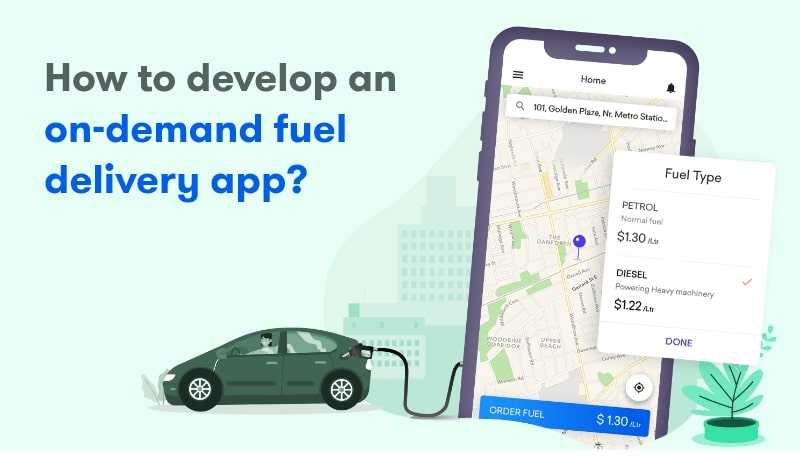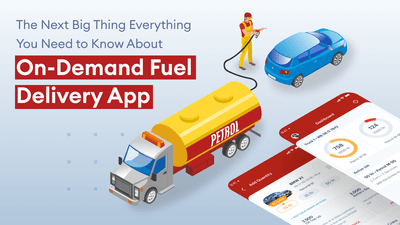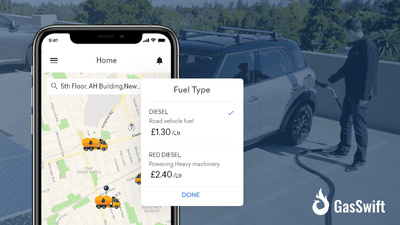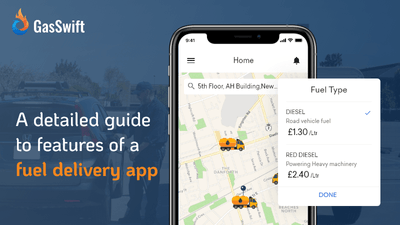Who would have thought ten years ago that we will get our favourite food or a cab on our doorsteps? But with the emergence of Dominos, Uber and other on-demand services, things have become easier. On-demand delivery apps have reshaped the global delivery economy by putting nearly every product or service at our fingertips instantly.

As per Harvard Business Review, the on-demand economy attracts more than 22.4 million (approx.) consumers yearly. It also attracts spending of $57.6 billion (approx.). After witnessing such a profitable opportunity, many emerging startups want to develop unique ideas of connecting people with products or services along with making their lives more convenient. And one such amazing idea is the on-demand fuel delivery app development.
On-demand fuel delivery apps are one of the top fuel delivery trends. It has multiple advantages such as greater convenience, time-saving, cost-effectiveness, low maintenance costs, emergency assistance, etc.
In this blog, we provide you with an in-depth overview of the working, features, benefits and cost of developing an on-demand fuel delivery app.
How it works?
Creating an on-demand fuel delivery app can be the best decision for you. Before you start with the on-demand fuel delivery app development for your business, you need to get a better knowledge of its working. Here is how an on-demand fuel delivery app works:
Registration
Firstly, the user needs to create his account over an on-demand fuel delivery app with a mobile number, or email id, password, etc. Furthermore, customers can also complete their registration by using their social media plugin.
Order placement
Order placement is the next step that comes after the registration. Here the users have to enter the fuel details and brand. Also, they can get real-time fuel delivery updates. Furthermore, you can also offer multiple payment options to the customers.
Order processing
Once the customer places an order, the fuel delivery company will assign that order to the nearby driver.
Final Delivery
The driver will then set out for the delivery. He will access the accurate address with the real-time tracking feature of the on-demand fuel delivery app.
Order completion
Now comes the order completion stage. Here the user has to select his desired payment mode from the available payment modes. After the payment completion, the customer will get an online receipt of the fuel delivery that contains necessary details such as quantity, price, delivery time, driver name, taxes, etc.

Significant benefits of an on-demand fuel delivery app
An on-demand fuel delivery app can become successful only if it fulfils the requirements of both the business and the customer. Here are the benefits that a fuel delivery app can give you:
Convenience
Convenience is one of the biggest advantages of an on-demand fuel delivery app. With an on-demand fuel delivery app, customers can easily book fuel deliveries from anywhere and at any time.
Now the customers don’t need to travel a long distance to get fuel or need to stay in long lines of the fuel station. All they have to do is just open the on-demand fuel delivery app and order the fuel. In this way, a fuel delivery app will free up the customers from the hassles.
Standard Fuel
Fuel adulteration is an alarming issue for many fuel delivery businesses. Fuel adulteration is the only thing that makes the customer categorise good or bad quality fuel.
However, you can eliminate the fuel adulteration issue with an advanced on-demand fuel delivery solution. It prevents the storage of fuel for a long time to avoid fuel adulteration issues. This means you ensure a standard quality fuel which would make you the first preference for users over other petrol stations.
Fulfils emergency fuel requests
One more demand you are fulfilling with the on-demand fuel app is emergency availability. Often, customers face fuel issues in the middle of the road where there is no nearby access to fuel. Or in the morning, at the time of office, people find their vehicles run out of petrol. You can help your customers in such emergencies by providing them with a 24*7 fuel supply.
Read More: How on-demand Fuel Delivery app can benefit your business?
Must-have features of an on-demand fuel delivery app
Features are the most important aspect that makes an app successful in the markets. The same can be said for the fuel delivery apps too. So if you want to make your on-demand fuel delivery app stand out from the crowd then you need to integrate the below features in it:
Fuel meter
Fuel Meter is one of the most attractive features of an on-demand fuel delivery application. It lets you know the exact amount of fuel that you have refilled in the fuel tanker. Furthermore, it provides you with an accurate measurement of the fuel delivered into the client’s vehicle.
A fuel meter also helps the user to record the quantity of fuel that gets filled into the customer’s vehicles. This assures accurate fuel deliveries to the fuel companies.
Selection of fuel type and quantity
To make an on-demand fuel delivery app more user-friendly, you need to empower your customers with the capability to customize their needs. For this, you can avail your customers of an option to select the fuel type and quantity.
With this feature, the customer can select their desired fuel type from the available options and enter the desired quantity. Along with this, you can also let your customers pay with their preferred payment modes.
Data Management
Fuel trucks must maintain a lot of parameters under safe limits for safer fuel deliveries. That goes from the temperature & pressure inside the fuel chamber to the quality of the delivered fuel and before and after volume.
An on-demand fuel delivery app provides the admin with the daily fuel consumption data. It even provides a cloud handler that stores them in log form and feeds it to an analytics software for processing. This processed data can be used by planners and strategists to revamp the present game-plan accordingly.
Real-time tracking
Real-time tracking is not just a trend today, it has become a vital feature of an on-demand fuel delivery solution. With the real-time tracking feature, you can track the live location of your drivers. It helps you to plan the delivery routes in advance to avoid road blockages and heavy traffic.
Apart from this, real-time tracking can help you to detect the driver activities so that you limit harsh driving activities such as sharp turns, over speeding, unnecessary vehicle idling, rash driving, speed limit violations, etc. Controlling such activities can help you to improve your driver’s behaviour which will eventually increase your fleets’ productivity.
Multiple payment integration
Ease of payments becomes essential when you adopt an on-demand business model. So while integrating multiple payment methods into your fuel delivery app solution, you should include credit card, debit card, net banking, mobile wallets, etc.
In addition to this, you should also need a secure payment gateway to provide the customers with a convenient and safer payment experience. You can try popular payment gateways such as Paypal, Stripe, Hyperpay, Worldpay, etc.

Steps to develop a top-notch on-demand fuel delivery app
After discussing the benefits and features of an on-demand fuel delivery app, let us look at the essential steps that are involved in the working of an on-demand fuel delivery app:
Acquire essential permissions
Before developing a profitable on-demand fuel delivery app, you must have to acquire all the necessary permissions from the relevant authorities. There are many authorities such as Petroleum and Explosives Safety Organisation (PESO) that provide regulatory guidelines for the fuel and gas delivery companies.
So if you are thinking of on-demand fuel and gas delivery app development, then you have to ensure that your app is compliant with the relevant laws and regulations for gas delivery.
Problem Identification
For building an on-demand delivery app, you first need to develop a business idea. This can be done with the identification of your customer’s day to day life problems. For that, you have to do a lot of research and brainstorming.
So look for the day to day problems of the customers and list each one of them. Once you have an exhaustive list, then start to think about how you can resolve them and shortlist the ones that make some sense.
Get a robust fleet
A well-equipped fleet is an integral part of an on-demand fuel delivery solution. Your fleet of fuel trucks must adhere to relevant regulatory and safety compliances of the territory in which you are having your fuel delivery business.
Your fleet infrastructure must cover all the popular fuel types. Once your fleet is ready to operate, you need to build a technologically sound IT infrastructure for your business.
Design the best UI/UX
Now it’s time to develop an eye-catchy user interface for your on-demand fuel delivery app. For this, you need to create a graphic design that represents the look of your fuel delivery app.
Make your app design easier to understand for the customers and drivers. Ensure that this design can be easily used in presentations to sell your products to potential customers.
To make a visually appealing user interface, you can hire graphic designers or you can take the help of popular graphic designing websites such as Dribble, Pinterest, or Behance.
You can also use readymade templates to design your on-demand fuel delivery app’s user interface. And if you think that you can design your on-demand fuel delivery app on your own, then you should try Design Code or App Studio.
Launch your app
Once you get done with the app infrastructure part, it is time to finalize the list of smart sensors to be integrated into your solution, it’s time to start building the software part, adding mobile solutions in the form of apps.
Backend is an invisible part of app installation that includes numerous codes and a bunch of compatibility layers to make it interfaceable with other applications and devices.
Once the backend is developed, compatible applications and devices work in unison as a single solution.
Build a proper app marketing strategy
Your work is not finished by just making an advanced on-demand fuel delivery app and launching it successfully to the app markets. You need to market it properly. For this, you can carry out aggressive promotional campaigns on social media platforms.
Make attractive promotional videos that highlight the main features of your on-demand fuel delivery app. Upload these videos to YouTube and other popular distribution channels.
For the short term, you can run PPC (pay-per-click), and CPI (cost-per-install) paid ads to drive installs for your app. But long term, your focus should be blogging and SEO (search engine optimization) as they can drive more traffic to your website. This will let your app gain more attention when users search for solutions over multiple search engines.
Additionally, you can also use the App Store Optimization (ASO) techniques. It increases the chances of a higher organic search for your fuel delivery app on the app stores.
Marketing for your mobile app will never stop. Your strategies might change over time, but this will always be an ongoing process.
Post-launch activities
There has been a significant rise in mobile app users in the present decade. As a result, the need to collect accurate metrics is highly important. As the number of mobile app users steadily rises, the need to collect accurate metrics becomes increasingly important.
Work on your customer’s feedback. Understand which features of your app they like or which they don’t like. Remove the unnecessary features from your on-demand fuel delivery app and add the latest features as per the requirements of your customers.
So, these are the steps of the on-demand fuel delivery app development that you’re always going to be dealing with. Just execute your app development plan properly and make proper utilization of your app development budget.
Cost of making a successful on-demand fuel delivery app
The cost of developing an on-demand fuel delivery app depends on multiple factors such as platform type, app type, duration of development, front and back end development, technologies, testing tools, etc.
Read More: How much does it cost to make an On-demand fuel delivery app?
After considering the above-mentioned factors, we can say that an on-demand fuel delivery app development can cost you somewhere around $13,000 to $25,000. Please note that this is an estimated cost that is subject to change with the addition of extra functionalities and features.
Final Words
On-demand fuel delivery apps are gradually getting successful in many parts of the globe. In the upcoming years, we can expect a lot of new entrants who will set up their on-demand fuel delivery businesses.
At GasSwift, we believe in the uberisation of oil and gas delivery businesses by providing them with top-notch fuel delivery solutions. If you want to make a profitable fuel delivery app, then you can reach us out at any time.
Hope this blog has provided you with enough information about the on-demand fuel delivery app development. Thanks, for reading this blog.




